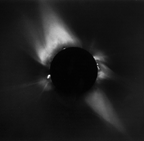
 The Sun's outer atmosphere, the corona, extends to many times the diameter of
the Sun. But the corona can only be seen well in visible light from the earth
during eclipses of the Sun by the Moon because it is millions of times fainter
than the photosphere, the visible surface of the Sun. Because of its high
temperature, the coronal plasma is highly ionized, and the corona is thus
visible in a variety of emission lines. Most of these spectral lines fall
outside the visible spectrum; in order to observe in those in the ultraviolet
and X-ray wavelength ranges which are absorbed by the earth's atmosphere, we
must observe from space.
The Sun's outer atmosphere, the corona, extends to many times the diameter of
the Sun. But the corona can only be seen well in visible light from the earth
during eclipses of the Sun by the Moon because it is millions of times fainter
than the photosphere, the visible surface of the Sun. Because of its high
temperature, the coronal plasma is highly ionized, and the corona is thus
visible in a variety of emission lines. Most of these spectral lines fall
outside the visible spectrum; in order to observe in those in the ultraviolet
and X-ray wavelength ranges which are absorbed by the earth's atmosphere, we
must observe from space.The Sun continuously blows off a magnetized plasma known as the solar wind which results from heating in the Sun's corona. The corona is permeated by magnetic fields that in some regions form closed loops and in others open almost radially to the external space. The open magnetic field regions are cooler and appear darker than the closed ones: they are called coronal holes. These are the source of fast solar wind streams. The measurements obtained by the SOHO instruments that observe the corona and measure the composition of the outflowing solar wind will help us to understand how the solar wind is accelerated.